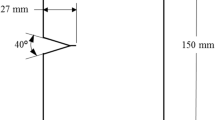Abstract
ASTM C1678 outlines an approach to estimate the fracture strength of glasses and ceramics through the use of empirical relationships relating the strength to characteristic fractographic length-scales, such as the ‘mirror radius’. However, the process of measuring radii is subjective, and the relationship suggested by ASTM standards has been shown to be relatively inaccurate for flexural stress fields. This research introduces and tests a visual analysis algorithm to carry out the fractographic analysis of silicate glasses automatically and objectively. The fracture surfaces of various silicate glasses produced by both tensile and flexural stress fields were considered. First, optical images of the fracture surfaces were gathered and unique; descriptive features such as the shape of the ‘mirror-mist boundary’ were extracted using visual analysis tools. Next, a newly developed algorithm compared the processed images with a database comprised of fracture samples of known strengths, fracture toughness, stress fields, and geometric features. Lastly, dimensional analysis principles coupled with a broad, experimental set of over 2100 fracture surfaces was used to accurately estimate the strengths of the imaged fracture surfaces.










Similar content being viewed by others
Notes
Toolbox used: Curve Fitting (version 3.4.11), Image Processing (version 11.1), Signal Processing (version 8.4), and Symbolic Math (version 8.5).
Abbreviations
- \(\sigma_{{\text{f}}}\) :
-
Fracture strength, MPa
- A :
-
Mirror constant, MPa√m
- R i :
-
Mirror radius, m
- H :
-
Thickness, m
- K Ic :
-
Fracture toughness, MPa√m
- D * :
-
Fractal increment
References
Standard Practice for Fractographic Analysis of Fracture Mirror Sizes in Ceramics and Glasses. C1678-10, ASTM (2010)
C. Brodmann, Nachrichten von der Gesellschaft der Wissenschaften zu Göttingen, Math.-Phys. Kl., 1894, 1, p 44–58. (in German)
L. Orr, Practical Analysis of Fractures in Glass Windows, Mater. Res. Stand., 1972, 12(1), p 21.
D.R. Oakley, Crack Branching in Float Glass Subjected to Biaxial Loading, J. Non-Cryst. Solids, 1996, 196, p 139–143.
R. Dugnani and R. Zednik, Flexural Strength by Fractography in Modern Brittle Materials, J. Am. Ceram. Soc., 2013, 96(12), p 3908–3914.
L. Ma, R. Dugnani and A. Moulins, Non-Linearity of the Mirror Constant for Glasses Fractured in Flexure, J. SJTU (Sci.), 2018, 23(1), p 182–189.
D. Hull, Fractography: Observing, Measuring and Interpreting Fracture Surface Topography, Cambridge University Press, Cambridge, 1999.
L. Ma, D. Djurdjanovic and R. Dugnani, Statistical Accuracy of Fractographic Estimation in Silicate Glasses with Design of Experiments and Pairwise T-Tests, Eng. Failure Anal., 2020, 116, p 104699.
A.I.A. Abdel-Latif, R.C. Bradt and R.E. Tressler, Dynamics of Fracture Mirror Boundary Formation in Glass, Int. J. Fract., 1977, 13(3), p 349–359.
M.J. Kerper and T.G. Scuderi, Relation of Fracture Stress to Fracture Pattern for Glass Rods of Various Diameters, Am. Ceram. Soc. Bull., 1966, 45(12), p 1065.
M.G. Norton and B.K. Atkinson, Stress-Dependent Morphological Features on Fracture Surfaces of Quartz and Glass, Tectonophysics, 1981, 77(3–4), p 283–295.
R. Dugnani and R.J. Zednik, Geometric Description of Fracture Surface Features in Isotropic Brittle Solids, Eng. Fract. Mech., 2016, 165, p 87–97.
L. Ma and R. Dugnani, Fractographic Analysis of Silicate Glasses by Computer Vision, J. Eur. Ceram. Soc., 2020, 40(8), p 3291–3303.
J.W. Johnson, D.G. Holloway, On the Shape and Size of the Fracture Zones on Glass Fracture Surfaces. Philos. Mag. 14(130), 731–743 (1798–1977)
G.D. Quinn and G.D. Quinn, Fractography of Ceramics and Glasses, National Institute of Standards and Technology, Washington, DC, 2007.
Studio Encoding Parameters of Digital Television for Standard 4: 3 and Wide-Screen 16:9 Aspect Ratios. BT, R. I. R. (2011)
R.C. Gonzalez, R.E. Woods and S.L. Eddins, Digital Image Processing Using MATLAB, Pearson Education India, Bengaluru, 2004.
Z. Kotevski, P. Mitrevski, Experimental Comparison of PSNR and SSIM Metrics for Video Quality Estimation, in International Conference on ICT Innovations, Sept 28, 2009 (Springer, Berlin, Heidelberg, 2009), p. 357-366
N. Shinkai, R.C. Bradt and G.E. Rindone, Fracture Toughness of Fused SiO2 and Float Glass at Elevated Temperatures, J. Am. Ceram. Soc., 1981, 64(7), p 426–430.
S. Dériano, A. Jarry, T. Rouxel, J.C. Sangleboeuf and S. Hampshire, The Indentation Fracture Toughness (KC) and Its Parameters: The Case of Silica-Rich Glasses, J. Non-Cryst. Solids, 2004, 344(1–2), p 44–50.
D.S. Harding, W.C. Oliver, G.M. Pharr, Cracking During Nanoindentation and Its Use in the Measurement of Fracture Toughness, in MRS Online Proceedings Library (1994), p. 356
M.J. Kerper and T.G. Scuderi, Relation of Strength of Thermally Tempered Glass to Fracture Mirror Size, Am. Ceram. Soc. Bull., 1965, 44(12), p 953.
J.J. Mecholsky, R.W. Rice and S.W. Freiman, Prediction of Fracture Energy and Flaw Size in Glasses from Measurements of Mirror Size, J. Am. Ceram. Soc., 1974, 57(10), p 440–443.
E.B. Shand, Strength of Glass—The Griffith Method Revised, J. Am. Ceram. Soc., 1965, 48(1), p 43–49.
M.J. Kerper and T.G. Scuderi, Modulus of Rupture of Glass in Relation to Fracture Pattern, Bull. Am. Ceram. Soc, 1964, 43, p 622–625.
O.E. Alarcón and P.P. Gillis, Fracture of Glass in Tensile and Bending Tests, Metall. Mater. Trans. A, 1994, 25(5), p 961–968.
J.J. Mecholsky and R.W. Rice, Fractographic Analysis of Biaxial Failure in Ceramics, Fractography of Ceramic and Metal Failures, ASTM International, West Conshohocken, 1984.
Author information
Authors and Affiliations
Corresponding author
Additional information
Publisher's Note
Springer Nature remains neutral with regard to jurisdictional claims in published maps and institutional affiliations.
Rights and permissions
About this article
Cite this article
Xiao, Y., Dugnani, R. Automated Quantitative Fractography of Silicate Glasses with Visual Analysis. J. of Materi Eng and Perform 30, 3612–3623 (2021). https://doi.org/10.1007/s11665-021-05697-1
Received:
Revised:
Accepted:
Published:
Issue Date:
DOI: https://doi.org/10.1007/s11665-021-05697-1




